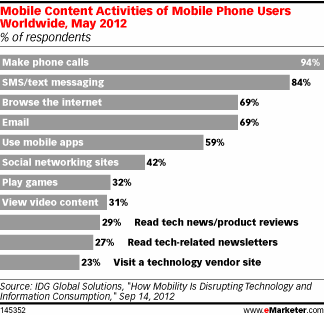When’s the next showtime for the movie? What’s the closest Indian restaurant nearby? Which movie did I see her in before? And which band was it that sang that song stuck in my head?!
If you’re equipped with a smartphone and a data plan, you are probably well-acquainted with mobile search already. In class, we’ve already discussed extensively about the necessity of webpage and search optimization. But with mobile activity quickly gaining ground, it wouldn’t be such a bad idea to consider the implications of optimization in terms of mobile websites. To put this into numbers, eMarketer reports that 69% of mobile users worldwide browse the internet on their phones. I believe it’s reasonable to infer that, among this segment, a substantial number of people have performed some form of mobile search.
Mashable reminds us not to neglect the mobile version of your website: “In short, mobile should be top of mind, because if people are searching, it’s because there’s an intent to do something.” As time is of the essence, users demand timely information that can facilitate their purchase decisions. Although mobile sites are often highly condensed to optimize loading times and usability, it is important to maintain a consistent brand. That means your mobile site should resemble its desktop sibling site in terms of both design and content.
In a similar vein, search giant Google has taken one step further to make mobile search all the more intuitive. Earlier this summer, the company enhanced its search prowess by introducing a handwriting recognition feature for Androids and iPhones. Google Handwrite allows users to scribble anywhere on their screen on the Google homepage to conduct a search. Although I can’t really see myself making use of this feature on a daily basis, I concede it’s a novel addition to the mobile search realm. With innovations like these, racking your brains will be a thing of the past – after all, “How does that song go again?!” will only be a couple of taps away.

One reply on “Search on the Go”
[…] sort of a follow-up to my previous post on mobile search, AdWeek reports that 72% of consumers believe it’s important for brands to have […]